By Diana K. Williams
Tires become worn over time and must be replaced, or they can become punctured and need repaired. The John Deere 100 series riding mower uses a snap ring system to hold the rear tire to the axle, making it easy to remove the wheel and replace it yourself, or to take it to a local dealer for repair without having to haul the entire tractor.
Park the mower on a level surface, turn off the engine.
Place the jack under the rear frame of the tractor near the center and jack up the rear of the mower.
Place blocks in front of both front wheels so the mower will not roll forward.
Place jack stands on each side of the jack, where the mounting bolts on the frame are located, and raise them up to meet the frame. They should be high enough that the tire will be off the ground when resting on the jack stands. Lower the weight of the tractor slowly onto the jack stands.
Remove the rear wheel’s plastic cap on the outer end of the axle by twisting it back-and-forth with your hand. This will expose a snap ring and washer.
Slide a flathead screwdriver under the snap ring and pop it out of the groove to remove it. Use care not to damage it. Remove the washer and slide the wheel off the axle.
Slide the new/repaired wheel onto the axle, replace the washer and then the snap ring. You may have to compress the snap ring to make it smaller to get it back into its original position. Ensure it is inserted completely in the groove because this is what holds the wheel on. Replace the plastic cap.
Jack the mower up off the jack stands, remove the stands and lower the mower slowly to the ground.
References
Resources
Tips
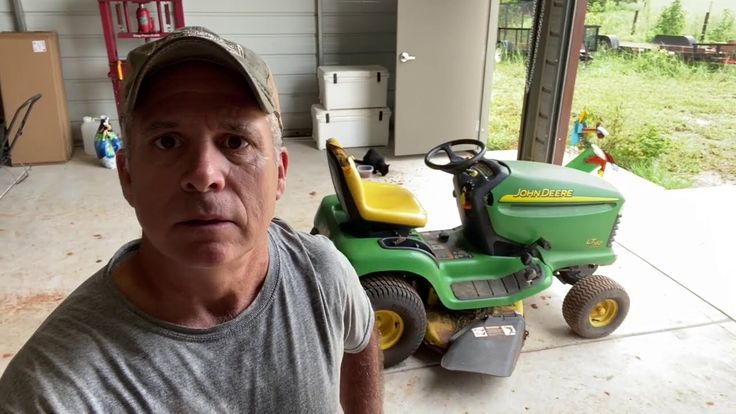 They work by placing the bent ends into the holes on the snap ring so you can compress and expand the ring as needed. Snap ring pliers come in a variety of sizes, so purchase the right size for your job.
They work by placing the bent ends into the holes on the snap ring so you can compress and expand the ring as needed. Snap ring pliers come in a variety of sizes, so purchase the right size for your job. Warnings
Writer Bio
Diana K. Williams is a certified Master Gardener, has more than a decade of experience as an environmental scientist, and holds a Bachelor of Science degree in biology and environmental studies from the Ohio Northern University. Williams is a winner of Writer’s Digest Magazine's annual writing competition.
Please enable javascript to view the website . .
.
Repair help > Front-Engine Lawn Tractor repair > Front-Engine Lawn Tractor repair guides
January 1, 2015
By Lyle Weischwill
This step-by-step repair guide explains how to change a front tire on a riding lawn mower if the old tire is damaged beyond repair. Replacing the front tire is fairly easy; you just need a few tools and a manufacturer-approved riding mower part.
Follow the steps in this repair guide and video to replace the front tire on Craftsman, Husqvarna, Toro, Troybilt, Ariens, Poulan, MTD, Murray, Snapper, Yard-Man, John Deere and Weed Eater riding mowers and lawn tractors.
If you'd rather use tire sealant to repair the tire, the video How to Repair a Riding Lawn Mower Tire shows how.
Quick links
Tools required
Floor jack or bottle jack
Jack stand
Slot screwdrivers
Pry bars
Pliers
Valve stem core removal tool
Liquid detergent
Water
Wood blocks
Work gloves
Safety goggles
Compressor air supply
Repair difficulty
Time required
60 minutes or less
Repair difficulty
Time required
60 minutes or less
Replacing a front tire on a riding lawn mower
This video explains how to replace the front tire on a riding lawn mower.
01.
Park the riding mower on a level surface and set the parking brake.
Turn the ignition switch off and remove the key.
Wear work gloves to protect your hands and safety goggles to protect your eyes.
Lift the riding lawn mower hood and disconnect the spark plug wire.
Lower the tractor hood.
Tip: Disconnect both spark plug wires if your engine has 2 cylinders.
PHOTO: Disconnect the spark plug.
02.
Block the rear tires to keep the riding mower from rolling.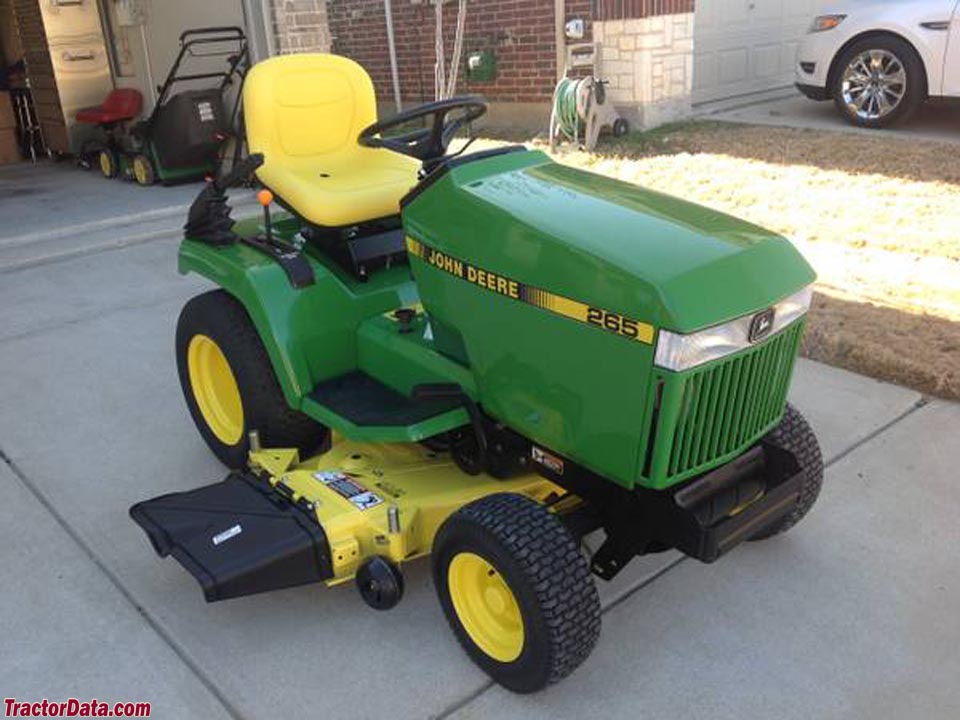
Position the jack under the frame and jack up the riding mower to raise the front wheel.
Place a jack stand under the frame to support the riding mower.
Remove the jack.
PHOTO: Block the rear wheel.
03.
Pull off the axle cover.
Remove the retaining ring and then pull off the washers.
Pull the tire off the axle.
PHOTO: Remove the front wheel.
04.
Remove the valve stem cap.
Remove the valve stem core, which lets any remaining air out of the tire.
Break the tire bead and pry the tire off the wheel rim on one side.
Pry the tire off the rim on the other side.
PHOTO: Pry the tire off the rim.
05.
Clean the wheel rim.
Set the new tire flat on a work surface.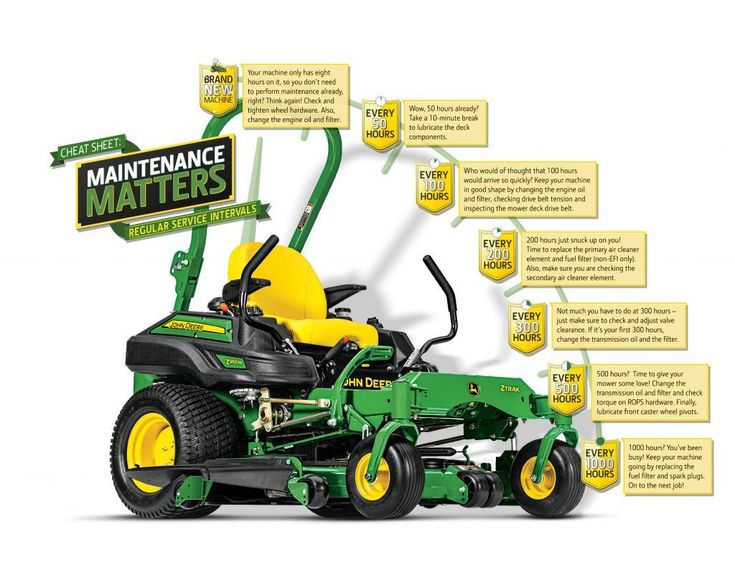
Lubricate the top tire bead with liquid detergent.
Pry the rim into the top side of the tire.
Flip the rim and tire over.
Lubricate the tire bead with liquid detergent.
Pry the remaining side of the tire onto the rim.
Warning: Use blunt tools to pry the tire to avoid damaging the new tire bead.
PHOTO: Lubricate the bead.
06.
Fill the tire with air to seat the tire bead.
Reinstall the valve stem core.
Fill the tire fully with air.
Tip: If the tire didn't fill with air, install a ratcheting tension strap around the center of the tire tread, tighten the strap to force the beads outward, and fill the tire with air to seat the tire bead. Carefully release and then remove the strap.
Tip: If the bead doesn’t seal, check the rim and replace it if you find damage.
PHOTO: Shoot air into the tire.
07.
Slide the wheel on the axle.
Reinstall the washers and snap the retaining ring onto the axle.
Push the axle cover onto the wheel.
PHOTO: Reinstall the wheel.
08.
Push the jack under the frame and raise the riding mower, and then pull out the jack stand.
Lower the riding mower to the ground.
Remove the wood blocks from the rear tires.
09.
Raise the tractor hood.
Reconnect the spark plug wire and lower the hood.
Tip: Reconnect both spark plug wires if your engine has 2 cylinders.
Warning: Undertaking repairs to appliances can be hazardous. Use the proper tools and safety equipment noted in the guide and follow all instructions. Do not proceed until you are confident that you understand all of the steps and are capable of completing the repair. Some repairs should only be performed by a qualified technician.
Some repairs should only be performed by a qualified technician.
Choose a symptom to see related riding mower and lawn tractor repairs.
Main causes: punctured tire or inner tube, leaky valve stem, damaged wheel rim
Read moreMain causes: worn or broken ground drive belt, bad seat switch, transaxle freewheel control engaged, transaxle failure, dirty carburetor
Read moreMain causes: shift lever needs adjustment, neutral control needs adjustment
Read moreMain causes: worn or broken blade belt, broken belt idler pulley, blade clutch cable failure, bad PTO switch, damaged mandrel pulleys
Read moreMain causes: damaged cutting blade, worn deck pulley, damaged mandrel pulley, loose fasteners on mower deck components
Read moreMain causes: engine overfilled with oil, leaky head gasket or sump gasket, damaged carburetor seals, cracked fuel pump, broken fuel line
Read moreMain causes: clogged carburetor, damaged flywheel key, dirty spark plug, stale fuel, improper valve lash, engine needs a tune up
Read moreMain causes: faulty battery, bad alternator
Read moreMain causes: unlevel mower deck, dull or damaged cutting blades, worn mandrel pulleys, bent mower deck, engine needs tune up
Read moreThese step-by-step repair guides will help you safely fix what’s broken on your riding mower or lawn tractor.
January 1, 2015
By Lyle Weischwill
Your mower can’t run on a damaged rear tire. Here’s how to install a new one.
Repair difficulty
Time required
60 minutes or less
Read moreJanuary 1, 2015
By Lyle Weischwill
If a blade on your mower is dull or bent, replace it following the steps in this repair guide.
Repair difficulty
Time required
30 minutes or less
Read moreJanuary 1, 2015
By Lyle Weischwill
Help your mower run better by replacing the fuel filter during your riding mower's annual tune-up.
Repair difficulty
Time required
15 minutes or less
Read moreUse the advice and tips in these articles and videos to get the most out of your riding mower or lawn tractor.
August 5, 2022
By Lyle Weischwill
Learn about Sears Technical Institute and the advanced technical content being developed for aspiring appliance techs.
Read moreAugust 6, 2020
By Lyle Weischwill
Learn how a blade removal tool makes replacing the blade easier and safer
Read moreApril 9, 2019
By Lyle Weischwill
Keep these 6 things on hand to keep the mower season running smoothly.
Read moreSamsung DVE52M7750V/A3-00 dryer parts
Shop GE JBP70WK4WW electric range partsShop Maytag MET8885XB02 electric range partsShop Kenmore 79096419406 electric range parts
Shop KitchenAid KEBS177YAL2 electric wall oven parts
Shop Model #917274961 Craftsman lawn tractor
Weatherking Furnace Repair Parts
Shop Craftsman 13953918D garage door opener parts
Shop Magic Chef 83EY-1 gas range partsShop Model #NX58K3310SS/AA-00 Samsung gas slide-in range
Shop MTD 31AS6HEG799 gas snowblower parts
Shop Craftsman 137212290 miter saw parts
Refrigerator Door Bin DA63-08646A
Refrigerator Parts CraftsmanNorge Refrigerator Repair Parts
Craftsman Snowblower attachment Repair Parts
Kenwood Speaker Replacement Parts
Shop Roper RT18HDXJW00 top-mount refrigerator parts
Shop Model #6209SR Roadmaster sidewalk wagon
Craftsman 12512008 wet/dry vacuum parts
About a year ago, Geektimes published an article about American farmer Dave Alford, who has been working on his own ranch for many years. The total area of the ranch is about 400 hectares. To cultivate all this land, Alford uses a large amount of machinery that breaks down regularly. Dave prefers to fix everything that is out of order on his own. nine0006
The total area of the ranch is about 400 hectares. To cultivate all this land, Alford uses a large amount of machinery that breaks down regularly. Dave prefers to fix everything that is out of order on his own. nine0006
Over the course of three decades, the rancher has repaired dozens of tractors. Not so long ago, he bought another one - a modern John Deere 8520T tractor. There is air conditioning and even an on-board computer. It can show, for example, the state of the engine. If something fails, the computer immediately shows which system is broken. It is very convenient - after all, you can fix everything, knowing where and what needs to be repaired. But this is where the convenience ends, since the farmer does not have the right to repair the tractor himself. nine0005
The fact is that the software of the tractor's on-board computer is protected by the manufacturer. The farmer cannot hack the DRM digital protection (although Alford knows how to do it, he says), since he will immediately fall under the Digital Millennium Copyright Act of 1998.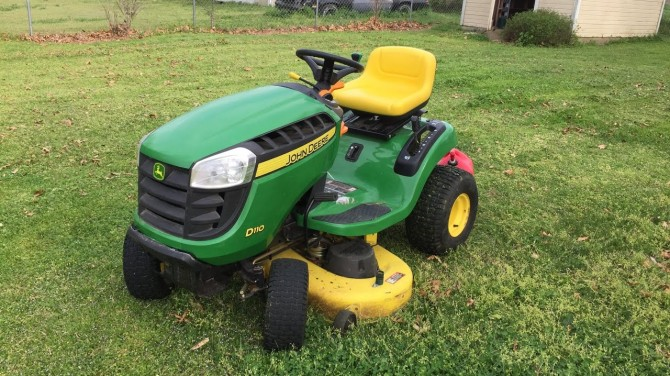 For violating the DMCA, the court can order the farmer to pay half a million US dollars or put him in jail for several years. So far, there have been no such precedents, but everything is possible.
For violating the DMCA, the court can order the farmer to pay half a million US dollars or put him in jail for several years. So far, there have been no such precedents, but everything is possible.
That is why Dave has to wait for a company specialist every time the tractor breaks down, or take the equipment to a service center, which is located 65 km from the ranch. All this time the work is worth it.
John Deere justifies the ban on self-repair of tractors by buyers by the fact that unskilled repairs can completely disable the system, and a self-appointed master can harm himself. It is clear that farmers do not agree with this point of view, believing that since the tractor is bought, then all rights to it belong to them. nine0006
Farmers' conviction that they should have full rights to repair their own equipment is supported by many other professions - lawyers, technicians, electronics specialists. But verbal support is one thing, and lobbying for interests is quite another. Someone had to be at the head of the team protecting the rights of farmers. That person was Kyle Wiens, founder of the iFixit community.
Someone had to be at the head of the team protecting the rights of farmers. That person was Kyle Wiens, founder of the iFixit community.
“I am not a lawyer. I am a repairman by trade and a software developer by education. I fix things - especially computer related stuff... When my farmer friend wants to know if there is a way to "tweak" his tractor's secure software, I know it's wrong. The only way to overcome the limitations of the DMCA is to ask the United States Copyright Office to make an exception to certain sections of the law ... In the past year, 27 proposed exceptions were considered - and one of them concerned the repair of equipment and software for agricultural systems, ”wrote Wiene. nine0006
According to him, anyone can apply for an exception to the law. After submitting a request, the development of the situation can only be observed, it is impossible to influence the process in any way. Vine did everything in his power. He supported several exceptions, helped prepare and properly file all documentation, and collected some 40,000 feedback in support of copyright reform. In addition to all this, the Copyright Office requires legally literate arguments for the proposed exceptions. A whole team of lawyers, found by Wiene, worked on this issue for about a year. nine0006
In addition to all this, the Copyright Office requires legally literate arguments for the proposed exceptions. A whole team of lawyers, found by Wiene, worked on this issue for about a year. nine0006
Ordinary people cannot hire an army of copyright lawyers. The main problem is money. Lawyers are very expensive, and good lawyers can cost a fortune. In the case of copyright reform, society is opposed by an army of well-trained and paid legal professionals who work in the interests of "Big Copyright". The DMCA is backed by the Motion Picture Association of America. Six major Hollywood studios are members of this association: The Walt Disney Company, Sony Pictures, Paramount Pictures, 20th Century Fox, Universal Studios, Warner Bros. The union also includes the Recording Industry Association of America, the Entertainment Software Association of America and the Alliance of Automobile Manufacturers. nine0006
All of these organizations are working hard to prevent copyright reform. Every proposed exception to the law is challenged by professional lawyers.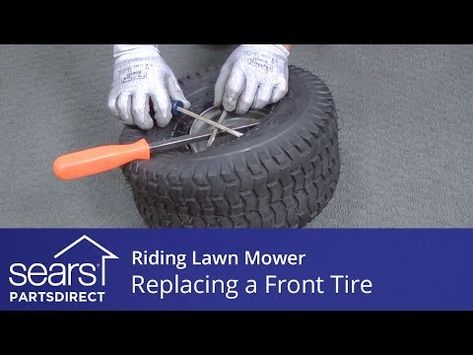 For this reason, exceptions to the law are rarely approved.
For this reason, exceptions to the law are rarely approved.
Last year, however, things did not go according to the usual scenario. A huge team of copyright experts volunteered to help the public "push through" the amendments to the law. Organizations such as the Electronic Frontier Foundation, Public Knowledge, the Southern California Intellectual Property Institute, and many others have participated in this process. The effort paid off — the US Copyright Office approved more exceptions in 2015 than ever before. One of the exceptions concerned the repair of tractors. nine0006
It would seem that everything is fine, we can celebrate the victory. But it turned out to be far from complete. Yes, exceptions have been approved. But with regard to tractors, there is an interesting nuance - only the farmer himself, the owner of the tractor, can repair them. Not a mechanic, not a hired specialist - but a farmer. Some of them are really able to do something on their own (when it comes to setting up on-board computer systems), but there are also ordinary users who know very well how the tractor works, but are not aware of what the on-board system software is. That is, you have to call a certified John Deere tractor repair specialist. nine0006
That is, you have to call a certified John Deere tractor repair specialist. nine0006
And most importantly, in three years everything will be back to normal. The amendments are valid for only three years. Three years later, exceptions to the law will have to be “pushed through” again. And even in the case of another success, the cycle will repeat itself. Here it is already necessary to ask for help not from the Copyright Bureau, it is necessary to demand changes in the legislation from the US Congress. Until Congress changes the DMCA, nothing will change.
Tractor 2005gv bought in 2008. Requires overhaul of engines. Front axle. nine0006
For John Deere, one of the leading manufacturers of high-quality and high-performance tractor equipment, the second half of 2005 was marked by the start of production of row-crop station wagons of the new 8020 series. to perform large-scale and voluminous agricultural work, the multifunctional machine was created taking into account the requirements of modern engineering and environmental standards, crop and fodder production technologies. nine0006
nine0006
RETROFIT APPLICATION FEATURES This model's traction and speed characteristics make it suitable for hauling heavy loads over rough terrain and paved public roads. The John Deere 8420 tractor is one of the most powerful in its series.
The operational advantages of this model:
The John Deere 8420 organically combines the classics of tractor construction with the introduction of advanced technical and technological solutions. nine0006
In particular, the compatibility of the linkage and onboard hydraulics with agricultural attachments and trailers of other brands has been preserved. The machine is fully adapted to difficult climatic conditions, which contributes to the stability of consumer demand in the domestic tractor market.
The machine is fully adapted to difficult climatic conditions, which contributes to the stability of consumer demand in the domestic tractor market.
The tractor is equipped with a branded six-cylinder turbodiesel with a displacement of 8.1 liters and a rated power of 285 hp. The liquid-cooled power unit differs from analogues in economical fuel consumption within 220 g / hp / h, a large margin of operating torque and the stability of this parameter in low-speed modes. nine0006
Equipped with electronic speed control and common rail high-pressure fuel injection (HPCR) allows you to use the engine's capabilities with high efficiency. The advantages of the power unit:
Torque from the flywheel of the engine is transferred to the power train by means of an electro-hydraulically controlled disc clutch mechanism.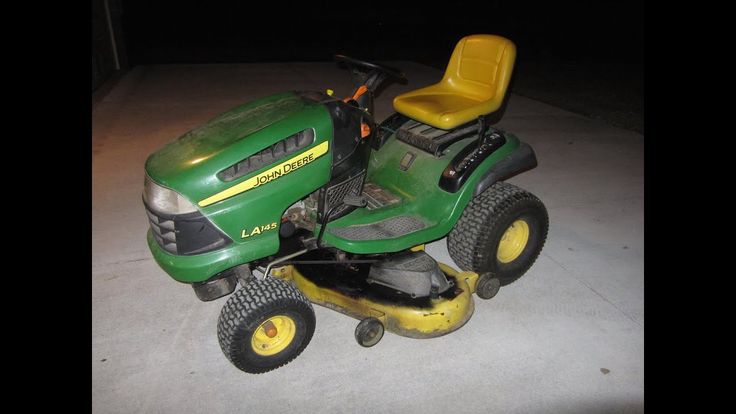
In the basic version, the tractor is equipped with John Deere PowerShift branded multi-speed gearbox, full power shift type. Sixteen forward speeds and two reverse speeds allow the operator to select the optimum work or transport speed.
The transmission also serves to drive an independent multi-mode PTO. Replaceable adapters of different diameters realize the full activation of mounted trailed and stationary units for various purposes. The transmission includes a front axle drive, a differential lock and effective disc brakes. nine0006
The all-wheel drive chassis of this model includes a unified rear axle and front elastic suspension 4WD Independent Link Suspension (ILS).
This combination allows you to increase the range of operating speeds up to 12-15 km/h, which equally positively affects the productivity of the machine and the quality of work performed on soils of any density.
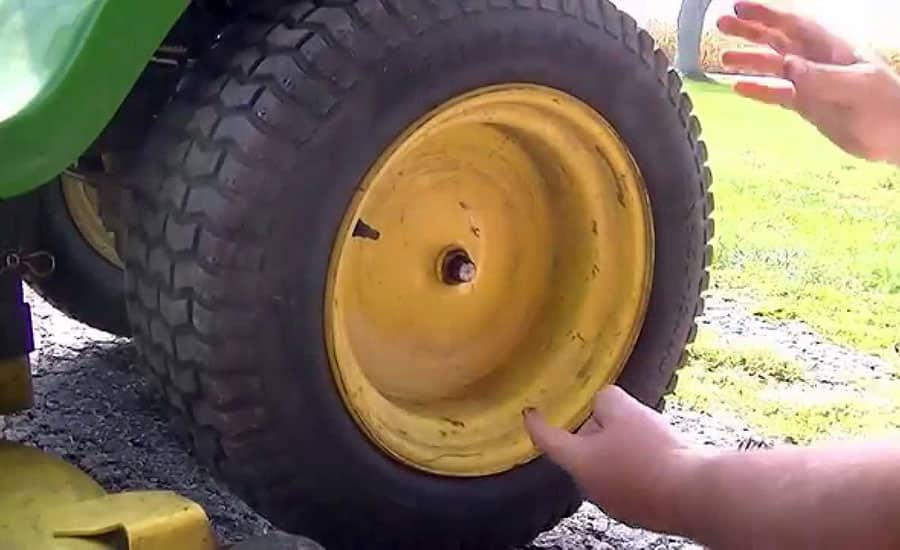 nine0053
nine0053 The products of this manufacturer are highly regarded for their combination of power, reliability and durability, increased productivity and ideal working conditions for the driver. In the list of other advantages:
With a sufficiently high power-to-weight ratio and a mass of 9800 kg, the 8420 model is characterized by very moderate overall dimensions (within 5.38x2.54x3.10 meters). nine0006
| Model | John Deere 8420 |
|---|---|
| Engine | 6-cylinder John Deere, turbocharged, diesel, liquid-cooled in-line |
| Power, hp/kW | 270/201.3 |
| Fuel tank capacity, l | 605.6 |
| Fuel consumption, l/h | 54.9 |
| Lifting capacity, kg | 6885/7847 |
| Oil change, hours | 250 |
| Gearbox, forward/reverse | 6/4 |
| Wheel size, front/rear | 16.9R30 18.4R46 |
| Wheel base mm | 3020/2980 (ILS) |
| Dimensions, mm length x width x height | 5380 x 2540 x 3100 |
| Weight kg | 9820/10455 (ILS) |
Comfort cab equipment includes:
